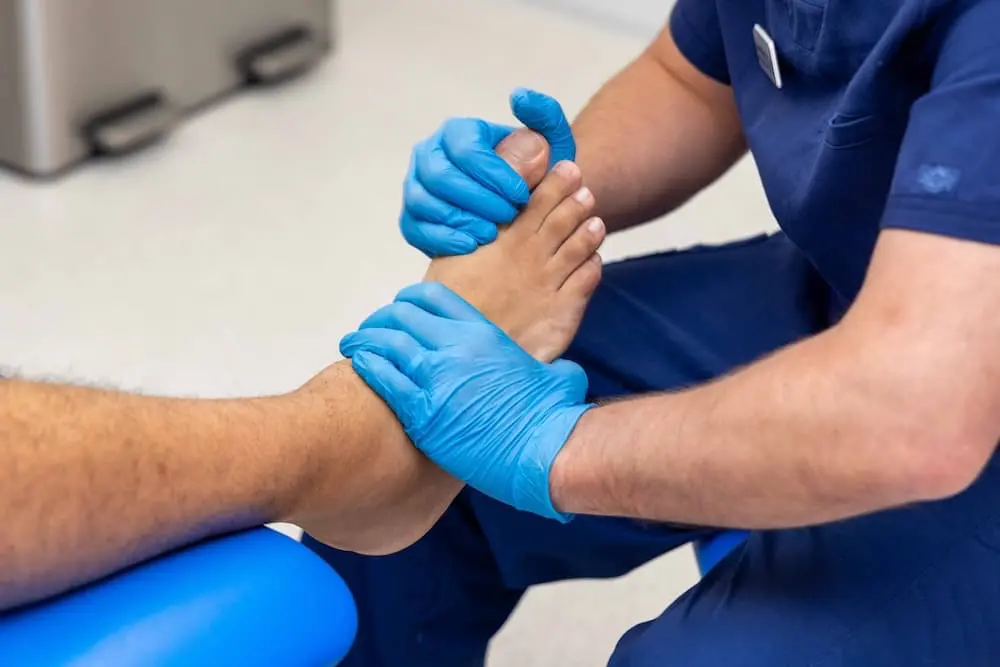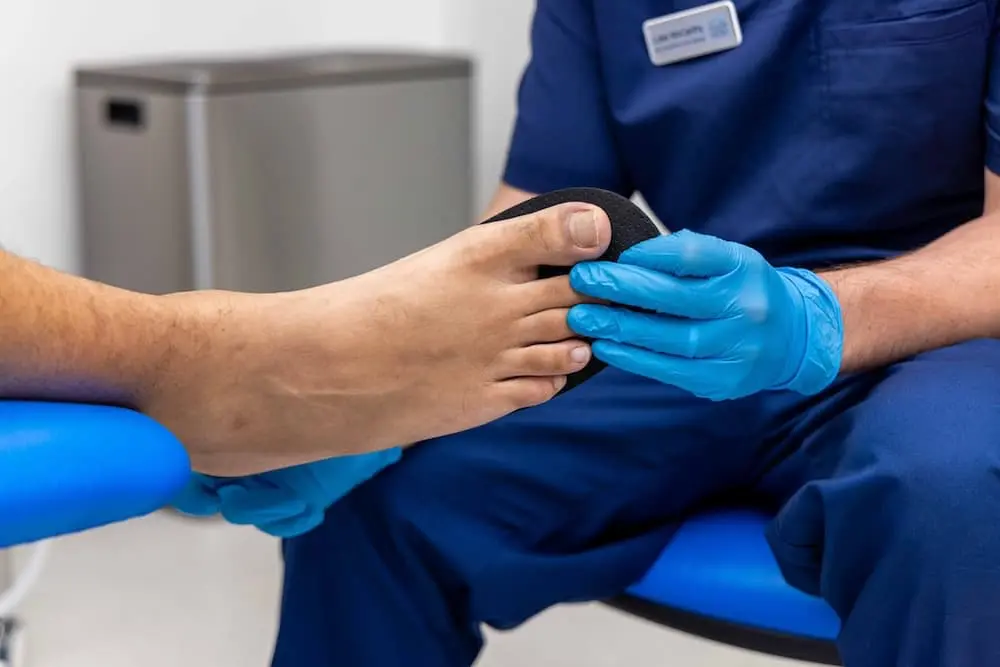METATARSALGIA TREATMENT
Are you tired of wincing with every step? Our expert podiatrists specialise in advanced treatments that target the root cause of your discomfort. Say goodbye to aching feet and hello to pain-free strides – whether you’re hitting the gym, exploring the outdoors, or simply enjoying a leisurely walk.

Services
WHAT IS METATARSALGIA?
Metatarsalgia is not a diagnosis, it is an umbrella term used for any condition that causes pain to the metatarsal area of the foot, often referred to as the “ball of the foot”. Once an assessment and diagnosis have been made, there are a range of treatments used to alleviate pain and discomfort in the ball of the foot. Metatarsalgia, can significantly impact your daily activities and quality of life.
Symptoms of metatarsalgia can be sharp, aching, or burning pain in the ball of your foot, which can intensify when you stand, walk, run, or flex your feet. Some patients describe the sensation as “walking on pebbles” or feeling like there’s a bunched-up sock under the foot, these symptoms vary depending on the cause of the Metatarsalgia.
WHAT CAUSES METATARSALGIA?
Metatarsalgia refers to pain in the metatarsal region at the front of the foot, it is not a diagnosis. The most common diagnoses leading to Metatarsalgia are nerve entrapment, tendon damage, ligament tear, arthritis, bursitis, stress fracture and changes to the skin such as a corn.
Metatarsalgia can stem from various factors, often involving excessive pressure on the metatarsal bones. Understanding these causes are crucial for effective treatment and prevention. Here are the primary factors that can lead to metatarsalgia:
Metatarsalgia can result from various factors that increase pressure on the metatarsal bones:
Foot Structure:
High arches, hammertoes, bunions, or unusually long metatarsal bones can alter weight distribution.
Footwear:
High heels, ill-fitting shoes, or worn-out athletic footwear can cause uneven pressure on the forefoot.
Physical Activities:
High-impact sports or sudden increases in exercise intensity can stress the metatarsals.
Medical Conditions:
Obesity, arthritis, Morton's neuroma, and diabetes can contribute to metatarsal pain.
Aging:
Natural thinning of the fat pad under the foot reduces cushioning.
Trauma:
Direct injuries or stress fractures in the foot can lead to metatarsalgia.
Occupation:
Jobs requiring prolonged standing or walking, especially on hard surfaces, can increase risk.


HOW CAN METATARSALGIA BE TREATED?
At MyFootMedic, we offer a comprehensive approach to treating metatarsalgia, from a thorough assessment and diagnosis to resolution, tailoring our methods to each patient’s specific needs. Our goal is not only to alleviate pain but also to address the underlying causes and prevent recurrence. Here are the primary treatment options we provide:
Physical Therapy:
Joint and soft tissue manipulation, stretching and strengthening exercises. Gait analysis and gait retraining
Insole and Orthotics:
Custom and prefabricated insoles and orthotics
Footwear:
Footwear advice and recommendations
Advanced Assessments:
Physical testing, ultrasound imaging, MRI/X-ray referral, blood test referral
Advanced Treatments:
Shockwave therapy, Ostenil injections, corticosteroid injections
Lifestyle Modifications:
Weight management guidance, activity modification, sports advice
Preventive Care:
Regular check-ups. Customised prevention strategies
Our experienced podiatrists develop personalised treatment plans, combining these approaches to effectively address your specific metatarsalgia case. Early intervention is key, so don’t hesitate to schedule an appointment if you’re experiencing persistent forefoot pain.
LET’S ANSWER YOUR METATARSALGIA QUESTIONS!
Symptoms of Metatarsalgia can often be fully resolved, and with proper care and management, most patients experience significant relief or complete resolution of symptoms. The prognosis largely depends on the underlying cause, the severity of the condition, and how promptly treatment is sought. In many cases, especially when caught early, metatarsalgia can be effectively managed through conservative treatments such as custom orthotics, appropriate footwear, and targeted exercises. These interventions often lead to long-term improvement or elimination of symptoms. However, for some patients, particularly those with structural foot issues or arthritis, metatarsalgia may require ongoing management to prevent recurrence of symptoms.
Walking can be beneficial for metatarsalgia when done correctly and with proper precautions. Gentle, low-impact walking can help maintain foot flexibility, improve circulation, and strengthen the muscles supporting the metatarsal bones. However, it’s crucial to approach walking strategically when dealing with metatarsalgia. At MyFootMedic, we recommend starting with short, pain-free walks and gradually increasing duration as tolerated. Proper footwear is essential – shoes with adequate cushioning and support can significantly reduce stress on the metatarsal areas. For many patients, we prescribe custom orthotics or metatarsal pads to redistribute pressure away from painful areas during walking. It’s important to listen to your body; if walking exacerbates pain, it’s best to rest and consult with one of our podiatrists. We can assess your gait, recommend appropriate modifications, and develop a personalised plan that allows you to enjoy the benefits of walking without aggravating your metatarsalgia. Remember, the key is finding the right balance between activity and rest to promote healing and prevent further irritation.
Ignoring metatarsalgia can lead to a cascade of negative consequences that extend beyond persistent foot pain. As the condition progresses without treatment, the discomfort can intensify, potentially causing chronic pain that significantly impacts your daily activities and quality of life. Untreated metatarsalgia may force you to alter your gait to avoid pain, which can lead to secondary issues such as knee, hip, or back problems due to improper body mechanics.
Over time, the ongoing stress on your metatarsal bones can result in more severe conditions like stress fractures or Morton’s neuroma. Additionally, the pain may cause you to become less active, potentially leading to weight gain and other health issues associated with a sedentary lifestyle. By addressing metatarsalgia promptly, you can prevent these complications, achieve faster relief, and return to your normal activities sooner.
Several factors can aggravate metatarsalgia, potentially intensifying pain and prolonging recovery. Wearing inappropriate footwear, particularly high heels or shoes with inadequate cushioning and support, can significantly worsen symptoms by increasing pressure on the metatarsal heads. Engaging in high-impact activities or suddenly increasing exercise intensity without proper conditioning can also exacerbate the condition. Excess body weight places additional stress on the forefoot, potentially worsening metatarsalgia. Continuing to walk or stand for extended periods without proper rest or support can lead to increased inflammation and pain. Ignoring early signs of discomfort and delaying treatment often results in the condition progressing and becoming more difficult to manage. Certain foot structures, such as high arches or hammertoes, can contribute to ongoing stress if not properly addressed.
Our podiatrists work closely with each patient to identify specific triggers and develop personalised strategies to mitigate these factors, promoting faster healing and preventing recurrence. By understanding and addressing what makes your metatarsalgia worse, we can create a more effective treatment plan tailored to your unique needs.
Metatarsalgia is an umbrella term used for any condition that causes pain to the metatarsal area at the front of the foot. It is important to have a thorough assessment to achieve the correct diagnosis and appropriate treatment plan. Often people will incorrectly interchangeably use the term Metatarsalgia and Morton’s Neuroma, but a Neuroma is just one cause of Metatarsalgia and many other conditions can cause Metatarsalgia. In more complicated cases, imaging can be used to differentiate the cause of your Metatarsalgia.
At MyFootMedic, our experienced podiatrists use advanced diagnostic techniques, including physical examinations, ultrasound imaging, and gait analysis, to pinpoint the diagnosis. We understand that proper diagnosis is the foundation of effective treatment, ensuring that you receive the most appropriate care for your specific condition. If you’re experiencing persistent forefoot pain, we encourage you to schedule a comprehensive evaluation to accurately identify the cause and develop a targeted treatment plan.
METATARSALGIA TREATMENT IN BEDFORD WITH MYFOOTMEDIC
Your Path to Recovery Starts Here. Metatarsalgia can be a challenging condition, but with proper care and treatment from MyFootMedic in Bedford, relief is within reach. If metatarsalgia is affecting your daily activities and causing discomfort, it’s time to take action. MyFootMedic is here to guide you through every step of your treatment journey. Book an appointment today with us today! Our experienced team is committed to helping you regain comfort and mobility.









